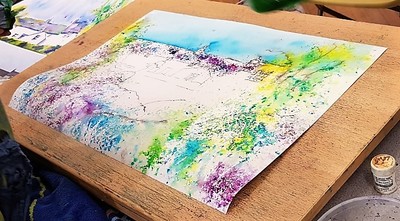 Judith started by explaining a little of the history of 'Brusho,' which was originally used as a fabric dye before artists starting using it for paintings. Brusho allows you to create visually stunning, expressive artwork with the minimum of fuss. It's fun to use, beginner-friendly and ideal if you want to learn how to create very contemporary, very striking images to hang on your wall or even sell. Because it's so loose and expressive, it can be faster to learn than traditional watercolour painting. It comes in small tubs and can last a long time. Some artists dip the brush in but Judith has made a small hole in the top of the tub and sprinkles the amount she requires on the paper. It can be used in many ways; spray and sprinkle, sprinkle and spray or like a watercolour. Judith started by sprinkling the powder on the paper and then spraying water on top. The first colour appeared to be blue but slowly changed into black, which was unusual. She then sprayed water onto the paper and sprinkled the colour into it, to show us the different effects that can be made. Wax can also be used, as a resist, to keep areas white and a diluted bleach solution can be used to lighten areas. Low tack masking tape can be used to mask off areas. After showing us how the paint could be applied, she drew out a composition in pencil on a heavyweight Bockingford rough paper, before going over some lines with a marker so as to not loose them when the paint was applied. Next, a few marks were made in the foliage with wax before starting on the sky. In a painting such as this with a busy foreground she likes a simple sky and applied this as a watercolour wash with a brush. This was left to dry over the break. Turquoise, Leaf Green, Purple and Yellow are sprinkled over the paper and then sprayed. Using the same colours the roof is applied and the windows are painted with the purple. As each area dries, she starts to add darks with a brush. This is similar to using watercolour paints; keeping the brushwork loose and adding shadows where needed. She wants the outside foliage to be like a window to the building. As more sections dry, she starts to add detail and highlights. Then she looks closer and decides the roof is too dark and demonstrates how to use the bleach solution to lighten it. Shadows are then added to the building where needed. Wanting lots of texture she continues to work on the foreground until she runs out of time. A fascinating introduction into this medium, by Judith, who always gives us lots of interesting facts and tips to improve our paintings.
2 Comments
|
Categories |








 RSS Feed
RSS Feed